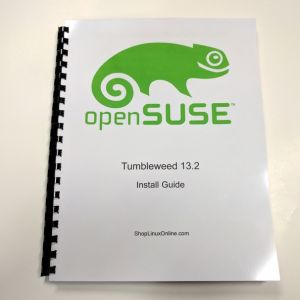openSUSE 42.2 Leap - Printed Manuals
OpenSUSE 42.2 Leap Printed manuals.
The openSUSE project is a worldwide effort that promotes the use of Linux everywhere. openSUSE creates one of the world's best Linux distributions, working together in an open, transparent and friendly manner as part of the worldwide Free and Open Source Software community.
The project is controlled by its community and relies on the contributions of individuals, working as testers, writers, translators, usability experts, artists and ambassadors or developers. The project embraces a wide variety of technology, people with different levels of expertise, speaking different languages and having different cultural backgrounds.
The openSUSE distribution is a stable, easy to use and complete multi-purpose distribution. It is aimed towards users and developers working on the desktop or server. It is great for beginners, experienced users and ultra geeks alike, in short, it is perfect for everybody! The latest release, openSUSE 13.2, features new and massively improved versions of all useful server and desktop applications. It comes with more than 1,000 open source applications.
openSUSE is also the base for SUSE's award-winning SUSE Linux Enterprise products.
Startup Guide
This manual will see you through your initial contact with openSUSE® Leap. Installation, Administration, Managing and Updating Software, The Bash Shell, Help and Troubleshooting
GNOME User Guide
This manual introduces you to the GNOME graphical desktop environment as implemented in openSUSE® Leap, and shows you how to configure it to meet your personal needs and pref- erences. It also introduces you to several programs and services. It is intended for users who have some experience using a graphical desktop environment such as Macintosh*, Windows*, or other Linux desktops.
Reference Guide
This manual gives you a general understanding of openSUSE® Leap. It is intended mainly for system administrators and home users with basic system administration knowledge.
Security Guide
This manual introduces the basic concepts of system security on openSUSE Leap. It covers ex- tensive documentation about the authentication mechanisms available on Linux, such as NIS or LDAP. It also deals with aspects of local security like access control lists, encryption and intrusion detection. In the network security part you learn how to secure your computers with firewalls and masquerading, and how to set up virtual private networks (VPN). This manual also shows you how to make use of the product's inherent security software like AppArmor (which lets you specify per program which files the program may read, write, and execute) or the auditing system that reliably collects information about any security-relevant events.
Tuning Guide
This manual introduces you to means to monitor and analyze your system. It describes methods to manage system resources and to tune your system. This guide does not offer recipes for special scenarios, because each server has got its own different demands. It rather enables you to thoroughly analyze your servers and make the most out of them.
Virtualization Guide
This manual offers an introduction to setting up and managing virtualization with KVM (Ker- nel-based Virtual Machine), Xen, and Linux Containers (LXC) on openSUSE Leap. The first part introduces the different virtualization solutions by describing their requirements, their installa- tions and SUSE's support status. The second part deals with managing VM Guests and VM Host Servers with libvirt . The following parts describe various administration tasks and practices and the last three parts deal with hypervisor-specific topics.


